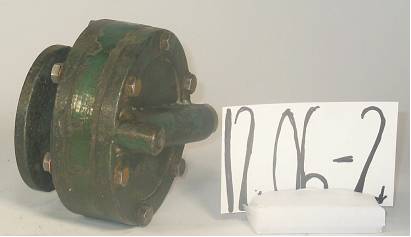Pressure Atomizing Oil Burner Equipment and Systems – Oil Pumps
A rotary, low pressure, fuel oil pump for automatic home heating, with carbon rotor separator blades, heavy steel rotor, in cast and machined steel body equipped for 4 bolt flange motor mounting, built-in, brass, automatic pressure regulating valve with manual adjustment, beginning to suggest the early years of the 4th wave in engineering design, characterized by compacted, integrated fuel oil pump assemblies, manufacturer unknown, Circa 1929.
Features: Natural carbon separator blades
Technical Significance:
From the vantage point of the early 21st century, the evolution of oil fired, automatic home heating equipment would be seen as generally advancing in four broad waves, each of which would take place over a considerable period of time, each producing many variations of the genre:
1. Vaporizing, non-motorized and non-electrified, technology [see Group 11.01 artifacts, no. 11.01-1]
2. Elemental, motorized, platform mounted technology with peripheral piping and valving components [see Group 12.01, artifact no 12.01-1, and pump assembly 12.06-1]
3. Compacted motorized technology with inherent, peripheral component parts engineered into the pump assembly [see pump assembly Group 12.06, artifact, and 12.06-2]
4. Functionally integrated, motorized technology, beyond being compacted, a number of functions would be smoothly integrated into a single pump assembly, including piping and valving [see Group 12.01, artifact 12.01-2 and pump assembly 12.06-2]
By the early 1930’s the Canadian oil heating industry was progressing well beyond simple, gravity feed, vaporizing oil-heating equipment [wave 1] and elemental, motorized, electrified, designs [wave 2], to increasingly more compacted and functionally integrated engineering designs. Seen here in the compact, coaxial motor drive flange and the built in pressure valve and piping passages.
This pump assembly is, then, an early marker of the 4th design wave
A hallmarks of the design is the use of carbon, separator, rotor blades. Carbon was a natural choice, as a natural substance, which tended to be self lubricating and self-positioning, wearing to cylinder wall to maintain a close running tolerance and quiet operation – all this in a period long before the availability of more sophisticated engineering materials
A hallmark of this technology of the period would also be its massive weight, as represented here by this 10 lb., toe crushing, partial pump body. But the look was a preferred one in the culture of the times, by a public still spooked by the seeming inherent dangers represented by un-attended, automatic oil heating equipment in the home. Among other things it must look, feel and in fact be solid.
Industrial Significance:
A marker of the sophisticated machining and manufacturing techniques of the times, using the relatively crude machine tools available.


